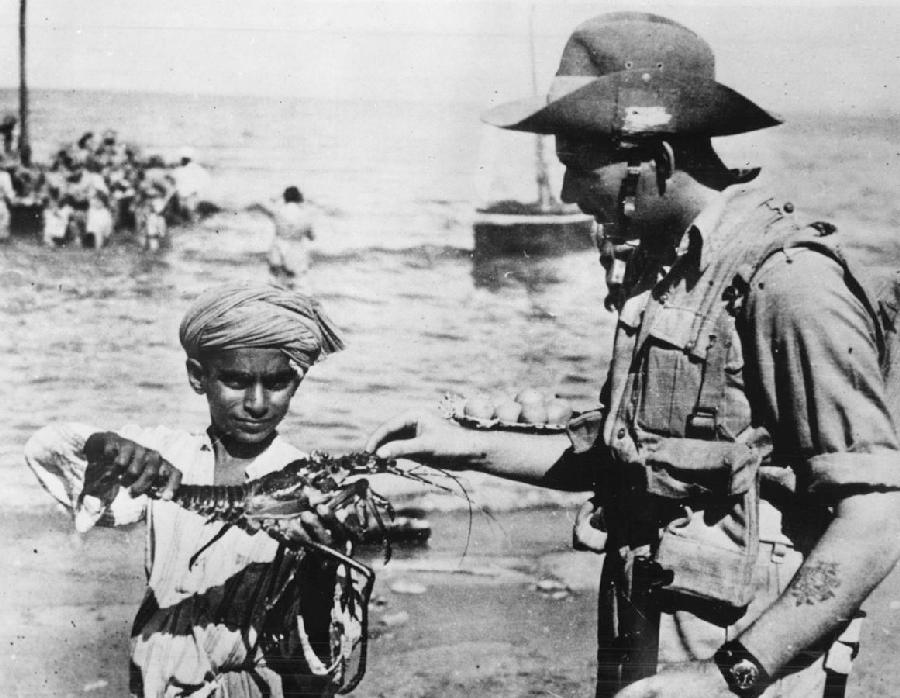
World War II: India--Allies Regroup in Eastern India (1942-43)

Figure 1.--India suddenly went from a colonial combatant in a distant war to a front-line state. The Allies launched major infrastructure projects (ports and rail lines) to support both the Indian Army and the Allied Armies. The CBI proved to be the theater with the lowest priority for both the British and Americans, but substantial forces were built up in eastern Infdua. This British solduer is contemplating a seafood dinner. The press caption read, "Seafood, Indian Style: Lobsters rate as a delicacy in India, too. This little Hindu dived into the sea and came up with a welcome catch which he offers to Pvt. H. Fordy, of county Durnham, England. Village where the little turbaned lad lives was recently visited by fifty British soldiers, part of the Wingate expedition, who toured the fishing hamlet on the edge of a vast desert."
|
|
The British and Chinese troops under American command after a harrowing retreat reached Assam and along with British-Indian forces braced for an attack. The British, Indian, Chinese, and a small American contingent finally managed to stop the Japanese who because of the teraine, rains, and lack of logistical support was unable to mount a major offensive into India. When the Japanese did not come, they began a major buildup wihin the limits of the low priority placed on the command which became known as the China, Burma, India (CBI) Theater. With the loss of the Dutch East Indies, the American-British-Dutch-Australian (ABDA) Command (ABDACOM) was reorganized (February 1942). The American (Nimitz and MacArthur) took resomsibility for the Pacific. The British assumed responsibility for southern Asia from Singapore to Suez, although Singapore and Burma quickly fell. The Nationalist Chinese (Chiang Kai-shek) continued to command the China Theater. Gen. Wavell fresh from the Middleast commanded forces in Burma and India from his headquartered in India, Gen. Stilwell after the retreat from Burma set up a new headquarters, the American Armed Forces: China, Burma, and India. His comand was primarily Chinese troops which hecturned into the finest units in the Nationalist Army. He also oversaw U.S. military advisory group and Major General Claire Chennaultís American Volunteer Group (AVG), better known as the Flying Tigers which eventually became part of Tenth Army Air Force. India suddenly went from a colonial combatant in a distant war to a front-line state. The Allies launched major infrastructure projects (ports and rail lines) to support both the Indian Army and the Allied Armies. The CBI proved to be the theater with the lowest priority for both the British and Americans. Even so very large quantities of supplies were delivered to support the Allied troops staging in eastern India. The primary American interest was to support the Nationalist Chinese. With the loss of the Burma Road this was primarily aviation fuel and other supplies for the American air operations in China. Eventually the Americans hoped to repon the Burma Road by driving the Japanese out of northern Burma. For the British, the goal was to defend India and then retake Burma. Both the British and Americans mounted commando operations in Burma. Major changes occurred in the Royal Indian Army. Thev Indian Army played a critical role in the Middle east during the first 2 years oof the War. When Japan entered the War, Indian units in the Middle East units had to be pulled back to defend India. The Japanese were surprised that the Indian Army remained loyal to the British. And the Indians would do much of the fighting in eastern India and Burma. At the onset of the War, many officers were British, especially the top commanders. By thec end of the War, most of the officers were Indian.
CIH -- - WW II

Navigate the CIH World War II Section:
[Return to Main World War II India page]
[Return to Main World War II country page]
[Return to Main World War II CBI page]
[Return to Main World War II Asian campaign page]
Return to Main Indian history page]
[Biographies]
[Campaigns]
[Children]
[Countries]
[Deciding factors]
[Diplomacy]
[Geo-political crisis]
[Economics]
[Home front]
[Intelligence]
[POWs]
[Resistance]
[Race]
[Refugees]
[Technology]
[Bibliographies]
[Contributions]
[FAQs]
[Images]
[Links]
[Registration]
[Tools]
[Return to Main World War II page]
[Return to Main war essay page]
Created: 3:43 AM 7/23/2013
Last updated: 3:43 AM 7/23/2013



